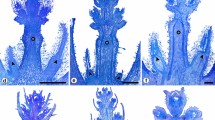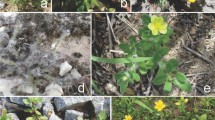Abstract
We examined the developmental morphology of the tropical Asian one-leaf plant Monophyllaea glabra, which is believed to have diverged first in the phylogenetic tree of the genus. The embryo within the seed consists of two cotyledons and a hypocotyl with no shoot or root apical meristems. The endogenous root meristem is formed nearer the hypocotyl end than in other examined Monophyllaea species. One of the cotyledons grows to form the macrocotyledon by means of the basal meristem. The groove meristem arises between the anisocotyledons, shifts toward the macrocotyledon, and is transformed to the inflorescence apex, which produces inflorescence axes in the axils of all ventral bracts of two rows, and secondary inflorescences in the axils of the lower dorsal bracts of the other two rows. The macrocotyledon may act as a ventral bract for the first inflorescence axis at the reproductive stage. This organization suggests that a common ancestor of Monophyllaea and Whytockia with decussate inflorescences diverged in one direction to become Monophyllaea and in another to become Whytockia.







Similar content being viewed by others
References
Alimova GK, Yakovlev MS (1982) A contribution to the embryology of Streptocarpus rexii (Gesneriaceae). Bot Zh 67:470–479
Barton MK, Poethig RS (1993) Formation of the shoot apical meristem in Arabidopsis thaliana: an analysis of development in the wild type and in the shoot meristemless mutant. Development 119:823–831
Bell AD (1991) Plant form. Oxford University Press, Oxford
Burtt BL (1963) Studies in the Gesneriaceae of the Old World, XXIV: tentative keys to the tribes and genera. Notes R Bot Gard Edinburgh 24:205–220
Burtt BL (1994) A commentary on some recurrent forms and changes of form in angiosperms. In: Ingram DS, Hudson A (eds) Shape and form in plants and fungi. Academic, London, pp 143–152
Caspary R (1858) Über die Anisocotylie von Streptocarpus polyanthus Hook. und Streptocarpus rexii Lindl. Verh Naturh Vereins Preuss. Rheinl Westphal, 15
Crocker CW (1860) Notes on the germination of certain species of Cyrtandreae. J Linn Soc (Bot) 5:65–67
Cronk QCB, Möller M (1997) Strange morphogenesis–organ determination in Monophyllaea. Trends Plant Sci 2:327–328
Hill AW (1938) The monocotylous seedlings of certain dicotyledons with special reference to the Gesneriaceae. Ann Bot NS 2:127–143, Plates III–V
Hilliard OM, Burtt BL (1971) Streptocarpus. University of Natal Press, Pietermaritzburg, South Africa
Imaichi R, Nagumo S, Kato M (2000) Ontogenetic anatomy of Streptocarpus grandis (Gesneriaceae) with implication for evolution of monophylly. Ann Bot 86:37–46
Imaichi R, Inokuchi S, Kato M (2001) Developmental morphology of one-leaf plant Monophyllaea singularis (Gesneriaceae). Plant Syst Evol 229:171–185
Jernstedt JA, Cutter EG, Gifford EM, Lu P (1992) Angle meristem origin and development in Selaginella martensii. Ann Bot 69:351–363
Jong K (1978) Phyllomorphic organization in rosulate Streptocarpus. Notes R Bot Gard Edinburgh 36:369–396
Jong K, Burtt BL (1975) The evolution of morphological novelty exemplified in the growth patterns of some Gesneriaceae. New Phytol 75:297–311
Lawrence WJC (1958) Studies on Streptocarpus Lindl. V. Speciation and gene systems. Heredity 12:333–356
Mayer V, Möller M, Perret M, Weber A (2003) Phylogenetic position and generic differentiation of Epithematheae (Gesneriaceae) inferred from plastid DNA sequence data. Am J Bot 90:321–329
Nishii K, Kuwabara A, Nagata T (2004) Characterization of anisocotylous leaf formation in Streptocarpus wendrandii (Gesneriaceae): significance of plant growth regulators. Ann Bot 94:457–467
Oehlkers F (1923) Entwicklungsgeschichte von Monophyllaea horsfieldii. Beih Bot Zentralbl 39:128–151
Rauh RA, Basile DV (2000) Induction of phyletic phenocopies in Streptocarpus (Gesneriaceae) by three antagonists of hydroxyproline-protein synthesis cell and developmental biology of arabinogalactan-proteins. In: Nothnagel et al (eds) Cell and developmental biology of arabinogalactan-proteins. Kluwer Academic/Plenum, Dordrecht, pp 191–203
Rauh RA, Basile DV (2003) Phenovariation induced Streptocarpus prolixus (Gesneriaceae) by β-glucosyl Yariv reagent. Can J Bot 81:338–344
Ridley HN (1906) Note on the foliar organs of Monophyllaea. Ann Bot 20:213–214
Rosenblum IM, Basile DV (1984) Hormonal regulation of morphogenesis in Streptocarpus and its relevance to evolutionary history of the Gesneriaceae. Am J Bot 71:52–64
Smith JF, Wolfram JC, Brown KD, Carroll CL, Denton DS (1997) Tribal relationships in the Gesneriaceae: evidence from DNA sequences of the chloroplast gene ndhF. Ann Mo Bot Gard 84:50–66
Tsukaya H (1997) Determination of the unequal fate of cotyledons of a one-leaf plant, Monophyllaea. Development 124:1275–1280
Weber A (1975) Beiträge zur Morphologie und Systematik der Klugieae und Loxonieae (Gesneriaceae). I. Die Sproβund Infloreszenzorganisation von Monophyllaea. R Br Bot Jahrb Syst 95:174–207
Weber A (1976) Beiträge zur Morphologie und Systematik der Klugieae und Loxonieae (Gesneriaceae) III. Whytockia als morphologische und phylogenetische Ausgangsform von Monophyllaea. Beitr Biol Pflanzen 52:183–205
Weber A (2003) What is morphology and why is it time for its renaissance in plant systematics. In: Stuessy TF, Mayer V, Hörandl E (eds) Deep morphology: toward renaissance of morphology in plant systematics. Gantner, Ruggell, Liechtenstein, pp 3–32
Acknowledgements
We are grateful to Mr. T. Wongprasert of the Forest Herbarium, Thailand, for his help during the field study, and to Mr. K. Hirai, Botanical Gardens, University of Tokyo, for growing the live materials used for this study. This study was supported by Grants-in-Aid for Scientific Research from the Japan Society for the Promotion of Science.
Author information
Authors and Affiliations
Corresponding author
Rights and permissions
About this article
Cite this article
Ayano, M., Imaichi, R. & Kato, M. Developmental morphology of the Asian one-leaf plant, Monophyllaea glabra (Gesneriaceae) with emphasis on inflorescence morphology. J Plant Res 118, 99–109 (2005). https://doi.org/10.1007/s10265-005-0195-5
Received:
Accepted:
Published:
Issue Date:
DOI: https://doi.org/10.1007/s10265-005-0195-5




